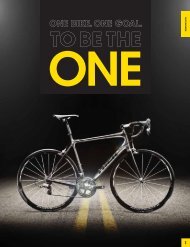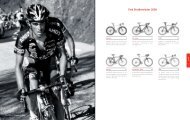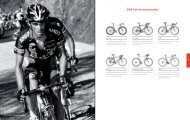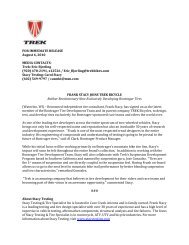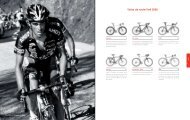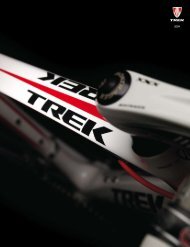Airfoil Development for the Trek Speed Concept ... - Slowtwitch.com
Airfoil Development for the Trek Speed Concept ... - Slowtwitch.com
Airfoil Development for the Trek Speed Concept ... - Slowtwitch.com
Create successful ePaper yourself
Turn your PDF publications into a flip-book with our unique Google optimized e-Paper software.
1.2 Initial Literature Search<br />
As in any scientific research project, <strong>the</strong> first step was to review any scientific literature available on <strong>the</strong> topic. After an exhaustive<br />
search, very little relevant literature was found. While general airfoils have been studied heavily throughout recent history, almost all<br />
such research has been directed towards high airspeed (75 mph to supersonic) aeronautical applications. For reasons discussed in <strong>the</strong><br />
next section, <strong>the</strong>se high-speed airfoils are nei<strong>the</strong>r practical nor effective on bicycles.<br />
A much smaller, though significant, amount of aerodynamic research has been conducted <strong>for</strong> automobiles. This research is again<br />
mostly irrelevant to bicycles due to <strong>the</strong> much higher speeds and thus very small yaw angles (yaw is described in Section 4). In addition,<br />
<strong>the</strong> parts of an automobile which are true airfoils are often asymmetric and designed to provide down-<strong>for</strong>ce. However, <strong>the</strong> overall<br />
automobile body itself experiences <strong>the</strong> same flow separation issues which are known to plague <strong>the</strong> low aspect ratio airfoils on current<br />
bicycles.<br />
Bicycles inhabit a small niche in aerodynamic science. There has been very little historical demand <strong>for</strong> such research because<br />
aerodynamic drag is of importance to very few devices which travel through air at 30 mph or less. Fluid dynamic behavior at such low<br />
speeds (low Reynolds Numbers) is notoriously difficult to study and predict [1, 2]. Fur<strong>the</strong>rmore, <strong>the</strong> stiffness and weight requirements<br />
of a bicycle create additional constraints. Finally, bicycles see much higher yaw angles than practically any o<strong>the</strong>r aerodynamic device<br />
because <strong>the</strong>y travel at speeds similar to <strong>com</strong>mon wind speeds.<br />
To cyclists looking to get an edge on <strong>the</strong> <strong>com</strong>petition, <strong>the</strong> lack of fundamental research in this subfield of aerodynamics is actually<br />
good news, as <strong>the</strong>re is still room <strong>for</strong> major advances in bicycle aerodynamics. <strong>Trek</strong> is at <strong>the</strong> <strong>for</strong>efront of this field, dedicating immense<br />
engineering resources towards true scientific research, not towards marketing hype.<br />
1.3 <strong>Airfoil</strong> <strong>Development</strong>: February – October 2008<br />
The lack of fundamental research of symmetric low-speed airfoils has left <strong>the</strong> bicycle industry grasping at straws. At worst, bicycle airfoil<br />
shapes are chosen because <strong>the</strong>y simply look unique or can be marketed as highly-engineered, though <strong>the</strong>y actually per<strong>for</strong>m poorly. At<br />
best, bicycle airfoil shapes are designed after <strong>the</strong> airfoils used in <strong>the</strong> aeronautical industry, such as <strong>the</strong> library of NACA airfoils. However,<br />
many of <strong>the</strong>se aeronautical airfoils do not work well <strong>for</strong> bicycles <strong>for</strong> several reasons. First, generally high aspect ratio (slender) airfoils<br />
would make very heavy and/or flexible bicycle tubes. While it is possible to manipulate <strong>the</strong> NACA system to obtain a<br />
symmetric low aspect ratio airfoil, <strong>the</strong> system was primarily designed <strong>for</strong> high aspect ratio, asymmetric flying wings. Second, it is well<br />
known that <strong>the</strong> effectiveness of an airfoil highly depends on <strong>the</strong> Reynolds Number at which it operates [2], and bicycles operate at<br />
much lower Reynolds Numbers than aircraft. Third, <strong>the</strong> aerodynamics governing aircraft differ significantly to ground vehicles, which are<br />
limited to motion in one direction, as discussed in Appendix 2.<br />
In early 2008, <strong>Trek</strong> engineers decided that <strong>the</strong> status quo had to change if bicycle aerodynamics were going to take any true scientific<br />
leap <strong>for</strong>ward. This leap would require <strong>the</strong> first fundamental study of low-speed airfoils specifically designed <strong>for</strong> bicycles, and <strong>Trek</strong><br />
was in <strong>the</strong> unique situation of having both <strong>the</strong> engineering resources and expertise to take on this historically neglected subset of<br />
aerodynamics. This project would fly <strong>com</strong>pletely under <strong>the</strong> radar within <strong>Trek</strong>. There would be no timelines, deadlines, or ties to o<strong>the</strong>r<br />
projects – this research would end only if and when true scientific discovery was made and would <strong>com</strong>pose of three phases:<br />
Phase 1: Develop a method <strong>for</strong> classifying and accurately testing airfoils using <strong>com</strong>putational fluid dynamics (CFD). Create<br />
a proprietary library of traditional airfoil geometries and drag data.<br />
Phase 2: Expand <strong>the</strong> CFD library to include non-traditional airfoil geometries. Consider no idea too wild to test and no<br />
traditional <strong>the</strong>ory too deeply-rooted to challenge.<br />
Phase 3: If Phases 1 or 2 resulted in true scientific breakthroughs, <strong>the</strong> most promising airfoil concepts would be refined and<br />
validated in <strong>the</strong> wind tunnel.<br />
5






